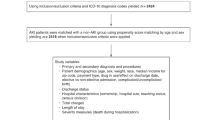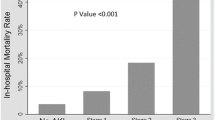Abstract
Objective
Acute kidney injury (AKI) is a common occurrence among hospitalized children and leads to increased mortality and prolonged length of stay (LOS) in critically ill patients. Few studies have examined the impact of AKI on LOS for common pediatric conditions. We hypothesized that a diagnosis of AKI would be associated with a longer hospital LOS and increased exposure to nephrotoxic medications for all patients.
Patients and methods
We performed a multicenter retrospective cross-sectional analysis of 34 children’s hospitals in the Pediatric Health Information System (PHIS) database from 1/2009 through 12/2013. Patients were grouped based on primary discharge diagnosis, number of days spent in an intensive care unit, and assignment of a secondary diagnostic code for AKI. Median LOS was compared among different patient groupings. Exposure to commonly used nephrotoxic medications was collected for each admission.
Results
A total of 588,884 admissions from 423,337 patients were included in the analysis. The median LOS among non-critically ill patients with and without AKI was 5 days [95% CI 3–10] versus 2 days [95% CI 1–4], respectively. Among critically ill patients, median LOS for those with and without AKI was 12 days [95% CI 7–20] versus 4 days [95% CI 2–7], respectively. Patients who developed AKI were more likely to have significant nephrotoxic exposure.
Conclusions
Development of AKI was associated with longer hospital length of stay and increased nephrotoxic medication exposure for all diagnostic categories. Non-critically ill children with AKI were hospitalized the same length or longer than critically ill children without AKI.



Similar content being viewed by others
References
Sutherland SM, Ji J, Sheikhi FH, Widen E, Tian L, Alexander SR, Ling XB (2013) AKI in hospitalized children: epidemiology and clinical associations in a national cohort. Clin J Am Soc Nephrol 8(10):1661–1669
Kirkendall ES, Spires WL, Mottes TA, Schaffzin JK, Barclay C, Goldstein SL (2014) Development and performance of electronic acute kidney injury triggers to identify pediatric patients at risk for nephrotoxic medication-associated harm. Appl Clin Inform 5(2):313–333
James MT, Hobson CE, Darmon M, Mohan S, Hudson D, Goldstein SL, Ronco C, Kellum JA, Bagshaw SM (2016) Applications for detection of acute kidney injury using electronic medical records and clinical information systems: workgroup statements from the 15(th) ADQI Consensus Conference. Can J Kidney Health Dis 3:9
McGregor TL, Jones DP, Wang L, Danciu I, Bridges BC, Fleming GM, Shirey-Rice J, Chen L, Byrne DW, Van Driest SL (2016) Acute kidney injury incidence in noncritically ill hospitalized children, adolescents, and young adults: a retrospective observational study. Am J Kidney Dis 67(3):384–390
Kari JA, Alhasan KA, Shalaby MA, Khathlan N, Safdar OY, Al Rezgan SA, El Desoky S, Albanna AS (2018) Outcome of pediatric acute kidney injury: a multicenter prospective cohort study. Pediatr Nephrol 33(2):335–340
Kaddourah A, Basu RK, Bagshaw SM, Goldstein SL (2017) Epidemiology of acute kidney injury in critically ill children and young adults. N Engl J Med 376(1):11–20
Schneider J, Khemani R, Grushkin C, Bart R (2010) Serum creatinine as stratified in the RIFLE score for acute kidney injury is associated with mortality and length of stay for children in the pediatric intensive care unit. Crit Care Med 38(3):933–939
Bresolin N, Bianchini AP, Haas CA (2013) Pediatric acute kidney injury assessed by pRIFLE as a prognostic factor in the intensive care unit. Pediatr Nephrol 28(3):485–492
Sutherland SM, Byrnes JJ, Kothari M, Longhurst CA, Dutta S, Garcia P, Goldstein SL (2015) AKI in hospitalized children: comparing the pRIFLE, AKIN, and KDIGO definitions. Clin J Am Soc Nephrol 10(4):554–561
Goldstein SL, Kirkendall E, Nguyen H, Schaffzin JK, Bucuvalas J, Bracke T, Seid M, Ashby M, Foertmeyer N, Brunner L, Lesko A, Barclay C, Lannon C, Muething S (2013) Electronic health record identification of nephrotoxin exposure and associated acute kidney injury. Pediatrics 132(3):e756–e767
Goldstein SL, Mottes T, Simpson K, Barclay C, Muething S, Haslam DB, Kirkendall ES (2016) A sustained quality improvement program reduces nephrotoxic medication-associated acute kidney injury. Kidney Int 90(1):212–221
Goldstein SL (2016) Medication-induced acute kidney injury. Curr Opin Crit Care 22(6):542–545
Mammen C, Al Abbas A, Skippen P, Nadel H, Levine D, Collet JP, Matsell DG (2012) Long-term risk of CKD in children surviving episodes of acute kidney injury in the intensive care unit: a prospective cohort study. Am J Kidney Dis 59(4):523–530
Askenazi DJ, Feig DI, Graham NM, Hui-Stickle S, Goldstein SL (2006) 3-5 year longitudinal follow-up of pediatric patients after acute renal failure. Kidney Int 69(1):184–189
Menon S, Kirkendall ES, Nguyen H, Goldstein SL (2014) Acute kidney injury associated with high nephrotoxic medication exposure leads to chronic kidney disease after 6 months. J Pediatr 165(3):522–527 e2
Chertow GM, Burdick E, Honour M, Bonventre JV, Bates DW (2005) Acute kidney injury, mortality, length of stay, and costs in hospitalized patients. J Am Soc Nephrol 16(11):3365–3370
Barrantes F, Feng Y, Ivanov O, Yalamanchili HB, Patel J, Buenafe X, Cheng V, Dijeh S, Amoateng-Adjepong Y, Manthous CA (2009) Acute kidney injury predicts outcomes of non-critically ill patients. Mayo Clin Proc 84(5):410–416
Hoste EA, Clermont G, Kersten A, Venkataraman R, Angus DC, De Bacquer D, Kellum JA (2006) RIFLE criteria for acute kidney injury are associated with hospital mortality in critically ill patients: a cohort analysis. Crit Care 10(3):R73
Barrantes F, Tian J, Vazquez R, Amoateng-Adjepong Y, Manthous CA (2008) Acute kidney injury criteria predict outcomes of critically ill patients. Crit Care Med 36(5):1397–1403
Alkandari O, Eddington KA, Hyder A, Gauvin F, Ducruet T, Gottesman R, Phan V, Zappitelli M (2011) Acute kidney injury is an independent risk factor for pediatric intensive care unit mortality, longer length of stay and prolonged mechanical ventilation in critically ill children: a two-center retrospective cohort study. Crit Care 15(3):R146
Fitzgerald JC, Ross ME, Thomas NJ, Weiss SL, Balamuth F, Anderson AH (2018) Risk factors and inpatient outcomes associated with acute kidney injury at pediatric severe sepsis presentation. Pediatr Nephrol 33(10):1781–1790
Waikar SS, Wald R, Chertow GM, Curhan GC, Winkelmayer WC, Liangos O, Sosa MA, Jaber BL (2006) Validity of international classification of diseases, ninth revision, clinical modification codes for acute renal failure. J Am Soc Nephrol 17(6):1688–1694
James M, Pannu N (2009) Methodological considerations for observational studies of acute kidney injury using existing data sources. J Nephrol 22(3):295–305
Siew ED, Basu RK, Wunsch H, Shaw AD, Goldstein SL, Ronco C, Kellum JA, Bagshaw SM, th ACG (2016) Optimizing administrative datasets to examine acute kidney injury in the era of big data: workgroup statement from the 15(th) ADQI Consensus Conference. Can J Kidney Health Dis 3:12
Acknowledgments
The authors would like to thank Matt Barhight, MD and Emily Mack, BS, MS for their contributions sharing data on local AKI diagnosis at Children’s Hospital Colorado. The authors would also like to thank the Research Institute of the University of Colorado and Department of Pediatrics for their support of the Pediatric Kidney Injury and Disease Stewardship team that helped with this project.
Financial Disclosure
Katja Gist is a consultant for BioPorto® Diagnostics. The other authors have no financial relationships relevant to this article to disclose.
Author information
Authors and Affiliations
Contributions
Dr. Searns, Dr. Gist, and Dr. Soranno conceptualized and designed the study, drafted the initial manuscript, and reviewed and revised the final manuscript. Meghan Birkholz designed the data collection instruments including our Pediatric Health Information System queries, collected and organized the dataset, and reviewed and revised the manuscript. Dr. Todd helped conceptualize the design for the study, revised our PHIS database query approach, and reviewed and revised the manuscript. Dr. Brinton and Kaci Pickett provided statistical analysis and design for the study and reviewed and revised the manuscript. All authors approved the final manuscript as submitted and agreed to be accountable for all aspects of the work. Dr. Searns and Dr. Gist serve as co-first authors on this manuscript.
Corresponding author
Ethics declarations
Conflict of interest
The authors declare that they have no conflicts of interest.
Additional information
Publisher’s note
Springer Nature remains neutral with regard to jurisdictional claims in published maps and institutional affiliations.
Rights and permissions
About this article
Cite this article
Searns, J.B., Gist, K.M., Brinton, J.T. et al. Impact of acute kidney injury and nephrotoxic exposure on hospital length of stay. Pediatr Nephrol 35, 799–806 (2020). https://doi.org/10.1007/s00467-019-04431-3
Received:
Revised:
Accepted:
Published:
Issue Date:
DOI: https://doi.org/10.1007/s00467-019-04431-3




